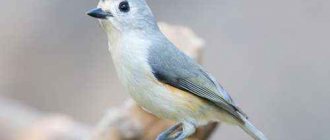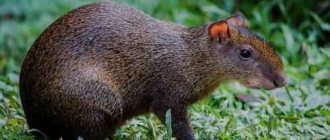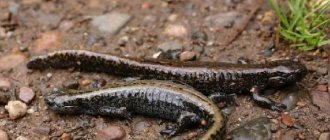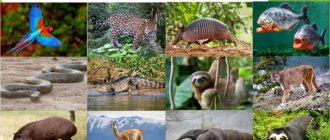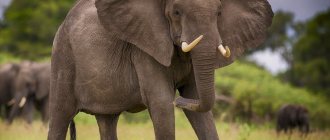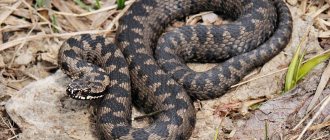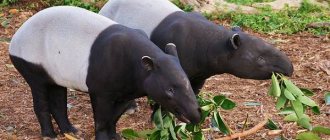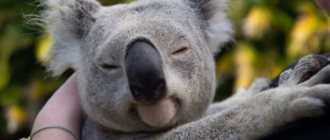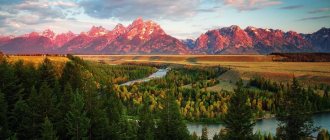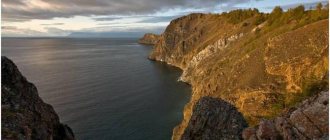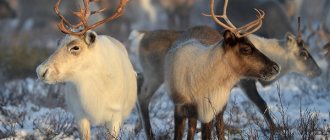South America is a continent whose fauna is incredibly rich and diverse. What animals live in South America and what plants grow there... want to know?
South America is the 4th largest continent among the rest of the world's continents. Every continent has something unique and unique, and South America is no exception.
Even a seasoned traveler has something to be surprised by; there are tropical rainforests, savannas and the Andes. This is a place of contradictions: Tierra del Fuego between Chile and Argentina is located in the cold Atlantic Ocean, the dusty steppes of Pampa stretch across Uruguay and Argentina, the majestic Andes with green valleys and coffee plantations rise from the west, in the north of Chile there is the Atacama Desert, which is the driest place in the world. On Earth, and in Brazil, in the area of the Amazon River, there are thickets of impenetrable jungle.
https://www.youtube.com/watch?v=AyFMCF_0G4A
The most dangerous animals in South America
Most of the planet's deadly poisonous creatures came from the fauna of South America . Here, for example, lives a frog that can kill 20 adults. Let's start the list with that.
leaf climber
Lives in rainy tropics. This is where the amphibian is dangerous. Individuals kept in captivity are not poisonous, as they feed on grasshoppers and fruit flies. In its natural environment, the leaf climber eats native ants. It is from them that the frog produces poison.
Only Leopis epinichelus can harm the leaf climber. This is a snake that is resistant to amphibian poison. However, if the eaten frog has managed to accumulate the maximum amount of toxins, the leopis also gets worse. Sometimes, after eating a bright yellow amphibian, snakes die.
The leaf climber is poisonous in the wild because it eats poisonous ants
Brazilian wandering spider
It is the most poisonous on Earth, which is confirmed by the entry in the Guinness Book of Records. The animal's neurotoxin is 20 times stronger than the black widow's secretion.
The wandering spider's venom makes breathing difficult. Men additionally experience long-term, painful erections. The bite itself is painful. You can be injured by a spider by taking dirty laundry from a basket, buying a package of bananas, or taking firewood from a woodpile. The name of the animal reflects its predilection to constantly move and climb everywhere.
The wandering spider is included in the book of records for its strong venom.
Spearhead nut
Like the wandering spider, it is one of the animals of South America that seek human settlements. The lancet viper is fast and excitable, so it often scurries around city streets.
With timely treatment, 1% of people bitten die. Those who delay visiting doctors die in 10% of cases. The viper's neurotoxins block the respiratory system and destroy cells, particularly red blood cells. The process is so painful that those bitten on the legs and arms require amputation even after successful administration of antivenom.
Shark
Instead of poison, she has the power of fangs. Cases of shark attacks on people are recorded all over the world, but most often in the waters of South America. The coasts of Brazil are notorious. Dozens of people have died from shark bites here.
Bull and tiger sharks operate in the waters of South America. Interestingly, until 1992 there were no attacks on people. The situation, according to scientists, changed after the construction of a port in the south of Recife. Water pollution has reduced the number of sharks' food supply. They began to eat garbage thrown from ships, swimming behind the ships to the coast.
The tiger shark has stripes on its sides resembling the coloration of a tiger.
Pictured is a bull shark
Triatomine bug
Otherwise called a vampire or a kisser, since it is sucked in the area of the lips and face. The insect feeds on blood while simultaneously defecating on the host. The bacterium that causes Chagas disease penetrates into the wound with feces.
In 70% of those bitten, it does not manifest itself, but in the remaining 30%, with age, it “results” in deadly neurological pathologies and ailments of the cardiovascular system.
The length of the kissing bug is 2.5 centimeters. The insect lives only in South America. Accordingly, Chagas disease is endemic. About 7 thousand people die from it every year on the continent.
The kissing mite is very dangerous; most often it attaches itself to the body in the lip area
Maricopa ants
Found in Argentina. An adult dies after 300 bites. One puncture is enough for 4 hours of acute pain.
Multiple Maricopa bites are rare, because the ants’ homes can be seen from afar. The height of the buildings reaches 9 meters, and the diameter reaches 2 meters.
Maricopa anthills are very tall and can be easily seen even from afar
Blue-ringed octopus
There is no antidote for its bites. The toxins of one individual are enough to cause the lightning death of an adult. At first the body is paralyzed.
In the waters of the seas washing South America, the animal reaches only 20 centimeters in length. The brightly colored animal seems cute, and the bite is painless. Impressions are deceiving.
Piranhas
Instead of poison, they have sharp teeth. The fish wield them deftly and attack in schools. At the beginning of the last century, in front of Theodore Roosevelt, who visited the continent, a cow was dragged into the Amazon. In front of the American president's eyes, in minutes the fish left only the bones of the animal.
Having spread rumors about killer fish in his homeland, Roosevelt did not take into account that the river was blocked for a couple of days, the seas of piranhas were starving. Under normal conditions, the inhabitants of the Amazon rarely attack. This usually happens if a person is bleeding. Its taste and smell attract piranhas.
Anaconda
It is mentioned in conversations about which animals in South America are dangerous, but are involved in human deaths only in unconfirmed stories and films. Anaconda attacks underwater, from ambush. Perhaps some of them went missing and died in the throats of giant snakes. However, there is no confirmation.
The anaconda stretches 7 meters in length. The weight of the animal can reach up to 260 kilograms.
Seven meters is the standard length of a snake. However, sometimes 9-meter anacondas are found. By the way, they belong to the subfamily of boas.
Anacondas have developed sexual dimorphism. Females are not only larger and heavier, but also stronger than males. It is the females that usually hunt large prey. Males are content with other snakes, birds, lizards and fish.
Black caiman
Among the 6 crocodiles inhabiting South America, the most dangerous to humans. The predator reaches 600 centimeters in length, that is, comparable to the American alligator.
In the Amazon region, about 5 fatal attacks of black caimans on people are recorded annually.
Reptile representatives
There are many reptiles on the mainland. Not all are dangerous to humans. Popular representatives include:
- Anaconda. Non-venomous snake, the largest on the planet. The length of the body can reach 10 m, weight - 260 kg. Capable of swallowing large animals and even humans. Hunts mainly underwater. It grabs its prey with sharp teeth, strangles it and swallows it. At the same time, its lower jaw shifts so much that an object larger than its head can enter its mouth. The snake feeds on large predators. It is not uncommon for even a jaguar to become its prey. But males prefer a modest dinner, including birds and small fish.
- Caiman. An aquatic predator, grows up to 5 m in length. It lives in water bodies and is dangerous to humans. The skin is black, it helps to hide while hunting at night. Predators feed on birds and mammals. Large prey are torn into pieces, and small ones are swallowed whole.
- The iguana is the largest lizard in the world. Prefers life in trees and feeds on plants. The average length is 50 cm, but there are individuals up to 2 m. Interestingly, the color of the reptile changes depending on its mood.
The elephant turtle also lives on the continent. It is much larger than its land relatives. Males are larger than females, weighing about 200 kg. Turtles spend a significant amount of time lying down. In good weather they gather in groups to bask in the sun's rays.
Food consists of grass and berries. During drought, water is obtained from cacti.
The largest and smallest animals on the continent
Animals in tropical areas are typically characterized by gigantism. The warm climate provides a rich food supply. There is something to eat on.
Orinoco crocodile
It is slightly larger than the black caiman. In theory, the Orinoco crocodile should be on the list of dangerous ones. However, the species is on the verge of extinction. The small number excludes mass attacks on people.
Male Orinoco crocodile weights reach 380 kilograms. The length of some individuals reaches almost 7 meters.
Orinoco, one of the largest species of crocodiles
Guanaco
The largest mammal on the continent. You could argue since the jaguar is bigger. However, the wild cat is also found outside of South America. Guanaco is found only here.
The guanaco is the ancestor of the llama. The animal gains weight up to 75 kilograms and lives in the mountains.
Noblela
This is already an animal from the list of miniatures. Noblela is a high-altitude frog that lives in the Andes. Adults are about a centimeter long.
Female nobles lay only 2 eggs, each one-third the size of an adult animal. There is no tadpole stage. The frogs hatch immediately.
Lilliput beetle
The smallest beetle on the continent. The length of the animal does not exceed 2.3 millimeters. Usually the indicator is 1.5.
The Lilliputian beetle is a recently discovered species. Externally, the insect is brown with hairy legs and three-lobed horns.
Hummingbird
Represents miniature birds. The length of the body, including the tail and beak, does not exceed 6 centimeters. The weight of the bird is 2-5 grams. Half of the volume is occupied by the heart. The bird has it more developed than anyone else on Earth.
The heart of a hummingbird beats 500 times per minute. If the animal is actively moving, the pulse increases to a thousand beats.
Test on the topic
- /10
Question 1 of 10How many climate zones are there in South America?
Start test
Hall of Fame
To get here, take the test.
- Yaroslav Kononov
10/10
- Denis Khristoforov
10/10
- Oleg Serezhin
7/10
South American animals listed in the Red Book
Most of the continent's Red Book inhabitants are forest dwellers. The jungle stretches along the Amazon and is actively being cut down for agricultural purposes and timber. 269 species of birds, 161 mammals, 32 reptiles, 14 amphibians and 17 fish are under threat of extinction.
Playful possum
Inhabits the northeastern coast of the continent. In particular, the animal lives in Suriname. The species is secretive and small in number; it belongs to small mammals.
The playful opossum walks little on the ground and climbs trees a lot. There the animal looks for insects and fruits, which it feeds on.
Titicaca Whistler
Endemic species of Titicaca. This is a lake in the Andes. The frog is not found outside its boundaries. The second name of the animal is scrotum. The frog is so named because of its flabby, hanging folds of skin.
The skin folds of the whistler increase the surface of the body, allowing more oxygen to be absorbed through the integument. The lungs of the Red Book animal are small. Additional “feeding” is required.
Vicuna
Like the guanaco, it is related to wild llamas, but less commonly, it lives only in the highlands of the Andes. Here the representative of the camelid family is protected from the cold by thick wool. Thin air isn't a problem either. Vicunas have adapted to oxygen deficiency.
Vicuñas have a long neck and equally elongated, thin legs. You can meet llamas at altitudes of more than 3.5 thousand meters.
Hyacinth macaw
Rare South American parrot. He has blue plumage. There is a yellow “blush” on the cheeks. Another distinctive feature is its long tail.
The Hyacinth Macaw is intelligent and easy to tame. However, catching the bird is prohibited because the species is protected.
Maned wolf
Found in the lands of Brazil, Peru and Bolivia. The maned wolf differs from other wolves in having long legs, like those of a heron. They are just as thin. The general appearance is reminiscent of a fox, in particular due to its red fur. It is raised on the ridge of the animal. Hence, in fact, the name of the species.
Maned wolves are rare animals in South America . The species is not found outside its boundaries. Predators do not need long legs for running. Animals of the savannahs of South America , called pampas, otherwise cannot survey their surroundings, drowning in tall grass.
The maned wolf has long legs, which helps him find food in the thickets
Pudu deer
The smallest among deer. The height of the animal does not exceed 35 centimeters, and the length is 93 cm. A pood weighs from 7 to 11 kilograms. Previously, the deer was found in Ecuador, Peru, Chile, Colombia, and Argentina. In the 21st century, the animal lives only in some parts of Chile and Ecuador.
Pudu is squat and wide, with a massive head, somewhat reminiscent of a wild boar. You can meet him on the seashore. There the pudu feeds on fuchsia, one of the algae.
Red ibis
He's really red, from head to toe. The color of the plumage, beak and skin is similar to the tone of tropical flowers, so bright. The bird gets its pigment from the crabs that it feeds on. The ibis catches prey with its long, curved beak.
The number of ibises has declined due to people's pursuit of feathers and poultry meat. The last time ornithologists counted 200 thousand individuals, including them in the International Red Book.
Peccary pig
Inhabits Mexico, Arizona and Texas. In the photo, the animals of South America may differ in nuances. Peccaries have 11 subspecies. All are medium-sized, not exceeding 100 centimeters in length and 50 centimeters in height. Peccaries weigh up to 25 kilos.
The peccary has a necklace of elongated hair on its neck. For this, the species is given a second name - collared. Representatives of the population are cautious, but hunters are often more cunning. South American pigs have tasty meat. Actually, by getting it, hunters reduced the number of bakers.
Where can residents of Russia see it in captivity?
From Russian zoos, spectacled bears were in the collection of the Moscow Zoo. They first appeared there back in 1955. Zoo specialists began breeding these animals in the 70s of the last century.
In 2015, the press mentioned among the zoo’s pets the spectacled bear Louise, born in 1989, that is, a veteran and old-timer. Now on the zoo's website there is no mention of spectacled bears among its pets.
If we talk about zoos in other countries, spectacled bears are kept in European zoos and zoos on the American continent, both in its northern and southern parts.
Animal symbols of South America
Every country and locality has a symbol from the animal world. There are 12 states on the continent. To these are added the overseas possessions of Great Britain and France.
Andean condor
From the name it is clear that the bird lives in the Andes, at an altitude of 5 thousand meters. The animal is large, reaching 130 centimeters in length and weighing 15 kilograms.
The condor's head is devoid of feathers. This reveals the bird to be a scavenger. However, sometimes the condor hunts small birds and steals other people's eggs.
Jaguar
Recognized as the national symbol of Argentina, where it has alternative names. The animals of South America are called cougars here. Sometimes the predator is called a puma, or mountain cat.
Most jaguars weigh 100-120 kilograms. The record is 158 kilos. Such a beast is capable of killing with one blow. By the way, this is how the name of the cat is translated from the Guarani language.
Alpaca
Associated with Peru. Living in the mountains, the ungulate has a heart that is 50% larger than the “engine” of other animals of the same size. Otherwise, alpacas will not survive in thin air.
Alpacas' incisors are constantly growing, like those of rats. The process is due to the tough and scarce grasses that animals feed on in the mountains. Teeth wear down, and without them you can’t get food.
Alpacas' teeth grow throughout their lives.
Pampas fox
Recognized as the national symbol of Paraguay. Their names make it clear that the animal lives in the pampas, that is, the steppes of South America.
Pampas foxes are monogamous, but lead a solitary lifestyle. Scientists are perplexed as to how animals find their chosen partner each year during the breeding season. After mating, the animals separate again to meet again a year later.
Pampas foxes lead an ascetic lifestyle
South Andean deer
This is the symbol of Chile. The species, along with the Pudu deer, is classified as endangered. The animal has a thick body and short legs. In summer, the South Andean deer grazes in the mountains, and in winter descends to their foothills.
The deer reaches 1.5 meters in length. The height of the animal does not exceed 90 centimeters. The animal is endemic to the Andes and is not found outside of it.
Rufous-bellied Thrush
Symbolizes Brazil. From the name of the bird it is clear that its belly is orange. The back of the bird is gray. The length of the animal is 25 centimeters.
Rufous-bellied blackbirds are animals of the forests of South America . Among the trees and their roots, birds look for insects, worms and fruits such as guavas and oranges. The thrush cannot digest fruit seeds. As a result, slightly softened grains are excreted in the feces. The latter serve as fertilizer. Seeds germinate faster. Thus, thrushes contribute to the increase in green areas.
Goatzin
It is the national bird of Guyana. The animal looks impressive, sporting a crest on its head and bright plumage. But from the point of view of the majority, hoatzin smells disgusting. The reason for the putrid “aroma” lies in the bird’s crop. There the hoatzin digests food. Therefore, a particularly pungent odor comes from the animal’s mouth.
Most ornithologists classify the hoatzin as a member of the gallinaceae order. A minority of scientists classify the symbol of Guyana into a separate family.
Bare-throated bell-ringer
Considered the symbol of Paraguay. The area around the eyes and throat of the bird is bare. Hence the name of the species. The skin of the throat is blue. The plumage of the birds is light, the males have snow-white plumage.
The bird was nicknamed the bell ringer for the sounds it made. They are generated by the males of the species. The voices of females are less sonorous.
Red Ovenbird
Associated with Uruguay and Argentina. The bird is large, with rusty plumage and a square tail. The animal is nicknamed the stove-maker due to the way it builds nests. Their complex design resembles a chimney.
The ovenbird's beak resembles tweezers. The birds grab insects for them. The stove hunter looks for them on the ground, where he spends most of his time.
The bird was nicknamed the stove maker for its ability to build nests that resemble a stove chimney.
Reproduction
Sexual maturity is reached between the ages of four and seven. Accurate information about that. when these bears have mating season in natural conditions, no. In zoos, babies are most often born in July and between December and February. Facts of the birth of offspring in the period from March to October have also been recorded, but such cases are infrequent.
The specificity of childbirth in this representative of the bear family is that the egg in the fertilized state divides, and then can be located inside the uterus of the bear, freely located there. That is, the animal has the ability of delayed implantation, when pregnancy as such occurs when it is possible to eat as much as possible.
The number of cubs in one female litter is from one to three. At the very beginning of life they are very weak and completely dependent on their mother. Already a month later, they come out of hiding together with the bear for the first time and begin to explore the world. Bear cubs develop very quickly.
They become independent at about eight months. At this age, the young individual no longer particularly needs maternal care and is ready to leave the mother. In some cases, cubs stay with their mother until they are two years old.
Scientists have attempted to mate the spectacled bear with its more common brown relative. It turned out that in this case a natural preservative of the purity of the species is triggered - the so-called reproductive isolation.
It was possible to obtain offspring from the crossing, but the cubs turned out to be in extremely poor health, practically unviable, and, most importantly, they had no reproductive function.
Unusual animals of South America
Many animals of the mainland are not only endemic, but also exotic, striking in their appearance.
A vampire
This is a bat. She has a snub nose. Sharp fangs protrude from under his upturned lip. With them, the vampire pierces the skin of the victims, drinking their blood. However, the mouse only attacks livestock. The bloodsucker doesn't bother people.
Vampires seem to care about their victims. Mice saliva serves as a natural pain reliever and contains substances that accelerate blood clotting. Due to this, animals do not feel bites, and wounds on the bodies of livestock heal quickly.
Tapir
Mentioned in conversations about which animals live in South America and are the most timid. Tapirs are indecisive, timid, and outwardly resemble something between an elephant and a boar.
Tapirs make a peculiar whistle. Scientists do not know what it means. The animals are little studied because they are shy and active at night rather than during the day. Of all mammals, tapirs are the dark horses of the scientific community.
Howler
This is a loud-voiced primate, belongs to the capuchin family. The animal is black. A reddish “mantle” of long hair hangs from the sides. The same ones grow on the face. But the tip of the howler's tail is bald. This makes it easier to grab the fruits that the monkey eats.
Howler monkeys reach 60 centimeters in length and weigh about 10 kilograms. The name of the animals is due to their loud voice. The loud call signs of howler monkeys can be heard several kilometers away.
Armadillo
He is a descendant of glyptodons. They looked almost the same, but weighed 2 tons and reached 3 meters in length. Glyptodons lived during the time of dinosaurs. Therefore, the armadillo is often called their peer.
The modern giant armadillo reaches a length of 1.5 meters. Other species of the animal are smaller, all but one live in South America. The remaining one is found in Northern.
What does it eat?
Spectacled bears are predominantly herbivores. Their favorite food is the fruits of plants of the bromeliad family, for which they, being excellent tree climbers, can climb to considerable heights. They also eat other plant foods, including even cacti.
Of course they love honey. According to the classification of gastronomic preferences, it is believed that only the giant panda is a more herbivorous species of bear than this one.
Like all other bears, it can also eat food of animal origin: birds, rodents, insects. Their prey could be a baby deer. During periods of starvation, they can even feed on carrion. There are cases when, during a great famine, bears made their way to people’s homes and attacked livestock.
Perhaps because of this, there was a misconception about the aggressiveness of these animals. Although in fact, in the natural environment and under normal conditions, they are very cautious and even shy.
Common animals of South America
If the scrotum frog is found only in one of the lakes of the continent, and the vicuña only in the highlands of the Andes, then these animals are found in almost every corner of South America. Despite the destruction of tropical forests and the pollution of ocean waters, some species continue to thrive in them.
coati
Otherwise called nosukha. The animal belongs to the raccoon family. Coatis are found everywhere, even climbing into the mountains to heights of 2.5-3 thousand meters. Nosushi can live in bushes, steppes, and rain forests. In addition to the mountains, animals are found in lowlands, which determines the large population.
The animal is nicknamed Noshoy because of its narrow head with an upturned lobe. The animal also has powerful, long fingers with claws and an elongated tail. These are devices for climbing trees.
Coati or Nosuha
Capybara
Otherwise called capybara. It is the largest rodent on the planet. The weight of the animal reaches 60 kilos. Some individuals are up to a meter in length. The appearance is similar to that of a guinea pig.
Capybaras are called aquatic because they live near water. There is a lot of succulent vegetation here, which the pigs feed on. Capybaras also love to swim, cooling off in the rivers, swamps, and lakes of South America.
Koata
Otherwise called spider monkey. The animal is black, slender, with elongated limbs and tail. Koats have hooked paws and a tiny head. In movement, the monkey resembles a tenacious spider.
The length of the coat does not exceed 60 centimeters. The average is 40. The length of the tail is added to them. It is approximately 10% greater than the length of the body.
Marmoset
This is the smallest monkey on the planet. The dwarf subspecies is 16 centimeters in length. Another 20 centimeters is occupied by the tail of the animal. It weighs 150 grams.
Despite their dwarfism, marmosets deftly jump between trees. In the tropics of South America, mini-monkeys feed on honey, insects, and fruits.
Marmosets are the smallest and very cute monkeys
Manta ray
Reaches 8 meters in length and 2 tons in weight. Despite its impressive dimensions, the stingray is safe, non-toxic and non-aggressive.
Considering the size of the manta ray's brain relative to its body weight, scientists have declared the animal to be the smartest fish on earth. The nature of South America is recognized as the richest on the planet. There are 1.5 thousand species of birds alone on the continent. There are 2.5 thousand types of fish in the rivers of the mainland. More than 160 species of mammals are also a record for one continent.
Where does it live?
The spectacled bear lives in mountainous areas - in the Andes and Cordillera. It is found in countries such as Panama, Venezuela, Bolivia, Peru, and Colombia.
Animals can rise to a height of 4 thousand meters above sea level. They live mainly in mountain forests. In search of food, they can descend into savannas and even reach shrubby plains, semi-deserts, and in rare cases, deserts.
Most often found in humid forests. In particular, in the territory of Peru in the eastern part of the Cordillera. They mainly live in mountainous areas from 1800 to 2700 meters above sea level, where heavy precipitation is observed - up to 3 thousand millimeters annually.
The lifespan of spectacled bears in the wild is unknown. Experts believe that she is unlikely to be older than 22 years. The maximum documented lifespan in captivity is 36.5 years.
These animals do not form stable married couples. To reproduce, the female mates with the male for a short time, but after giving birth to offspring, she feeds and raises the cub exclusively herself.
Fish
The southern part of the continent in America is located mainly in the Southern and Western Hemispheres of the planet. In the west it is washed by the Pacific Ocean, on the east side by the Atlantic, and in the north by the waters of the Caribbean Sea, thanks to which a huge number of fish live here.
Aravans
Freshwater fish from the Aravanaceae family and the Aravanaceae order, having a very laterally flattened and ribbon-shaped body covered with large scales. Fish feed on their small counterparts, and they catch flying insects by jumping out of the water.
Brown pacu
Freshwater ray-finned fish from the Piranha subfamily is today the largest representative of characins. The body is tall, noticeably laterally compressed. The color of representatives of the species varies from black to gray shades.
pennant piranha
A freshwater fish with a disc-shaped, highly laterally compressed body and an upward-pointing mouth, which is distinguished by a protruding lower jaw with irregular teeth. The body is silvery or partially greenish-silver in color.
Guasa
A large fish that lives mainly in tropical shallow waters and near coral reefs. Giant Atlantic groupers feed primarily on crustaceans and fish, but also eat octopuses and young sea turtles.
Striped Croaker
The fish from the Gorbylev family is large in size, has an elongated body of a dark gray color with a silver belly. The tail and fins are characterized by a yellow color. It feeds on various crustaceans, small fish and shrimp.
Common thorn
A freshwater schooling ray-finned fish with a flat body of a dark silver color and the presence of three transverse black stripes. The anal fin of the common thorn in appearance resembles an unfolded fan of black coloring.
Faloceras
Viviparous ray-finned fish from the Poeciliaceae family are widely used in modern aquarium farming. Many species of such freshwater fish have a round or noticeably elongated spot on the back of the body.
Speckled catfish
A ray-finned freshwater fish from the armored catfish family is distinguished by the presence of two pairs of antennae on the upper lip. The back area and fins are pale brown with many dark spots, and the belly is pinkish-golden.
Black knifeworm
The fish from the Apteronotaceae family is a predominantly nocturnal solitary predator, almost completely black in color, with the exception of a pair of white rings that are located near the caudal fin, as well as a light spot in the nose area.
Gray angelfish
A representative of the angelfish family, it has a light gray body with dark gray spots on each scale. The throat area, ventral and pectoral fins are dark gray in color, and the caudal fin has a blue border.
Red Phantom
A freshwater schooling ray-finned fish from the Characin family is distinguished by its bright color, does not stay in a certain place, constantly moves to the surface of the water or sharply descends towards the bottom soil of the reservoir.
Callicht
Ray-finned fish from the armored catfish family. The aquatic inhabitant has an elongated body, which is slightly flattened on the sides, covered with a pair of rows of special bone plates. This fish has three pairs of whiskers on the upper and lower jaws.
Palmeri
Freshwater ray-finned fish from the Characin family is distinguished by a white-yellow belly and a dark, narrow stripe running along the body. The dorsal area is olive-colored with a brown tint, and the translucent fins are yellow-green in color.
Leaf fish
A ray-finned freshwater inhabitant of the Polygonaceae family and the Perciformes order, its appearance resembles fallen yellow-brown leaves. On the upper part of the lower jaw there is a fixed antenna directed forward.
Bolivian butterfly
A representative of the Cichlid family is characterized by its small size. The average body length of an adult rarely exceeds 60 mm. With its coloration, the Bolivian butterfly resembles the closely related but smaller species Microgeophagus Ramirez.
Return to content
Natural areas
Despite the relatively small area of the mainland, several different natural zones were able to accommodate here.
Equatorial rainforests (selvas)
Located in the Amazonian lowlands. This natural area is characterized by moist ferrallitic soil, and therefore the plant life here is very diverse. It is represented by orchids, various ficus trees, melon trees, chocolate tree, various vines and ferns.
Savannahs (Llanos)
Savannas are located on the Guiana Plateau, the Orinoco Lowland, and the Brazilian Highlands. This natural area is characterized by a very warm and dry climate (with the exception of the south of the Brazilian Highlands, where the soil is very fertile and humid). Savannah is rich in animals: here you can find an ostrich, an anteater, a deer, and a baker pig.
Deserts and semi-deserts
The long chain of the Andes blocks the path to the deserts for humid air masses, so there is a very dry climate and sparse vegetation. Feather grass, various types of cacti, and low-growing grasses predominate. The soil here is clayey, infertile, and rich in salt.
Temperate forests (hemigilea)
This natural area is located at the foot of the Andes Mountains. Here, podzolic brown soils predominate, on which bamboo, magnolias, and cypresses grow in abundance. The fauna of the forests is represented mainly by bears and chinchillas.
Soils
The geographical location determines the wide variety of natural zones of the continent. Each natural zone is characterized by a special type of soil.
In areas of the continent where a humid and hot climate prevails, podzolized lateritic soils are mainly found. Red-brown and brown-red soils predominate in the subequatorial belts.
In desert and semi-desert zones, the soils are clayey and mineralized. In forest zones, brown forest soil predominates; closer to North America, gray soils and gray-brown soils predominate. The Andes are dominated by rocks.
Population
The total population is about 422 million people. The ethnic composition is very diverse: about 250 different races live here. Such a wide variety is due primarily to the history of the continent.
The inhabitants of the mainland can be divided into representatives of three races:
- equatorial (indigenous population - Indians),
- Caucasoid (descendants of European conquerors),
- Negroid (descendants of slaves brought from Africa).
In addition, representatives of mixed races live here:
- mulattoes (a mixture of Europeans and Africans),
- mestizos (a mixture of Europeans and Indians),
- sambo (a mixture of blacks and Indians).
Rapid mixing of peoples began to occur after the capture of the mainland by the Spaniards and Portuguese. Before that, five centuries ago, only indigenous Indian tribes lived here. The import of slaves from Africa was of great importance for the ethnic and cultural development of the continent: they brought their own special flavor.
Interesting Facts
You can talk endlessly about the South American continent.
Here are some interesting and little-known facts:
- One of the mainland countries - Brazil - is the absolute champion in the number of football matches won.
- Brazil is also the champion in the number of melodrama series produced.
- The continent is home to the wettest settlement in the world, the city of Buenaventura, and the driest desert, Atacama: there has been no precipitation here for 400 years.
- Most major cities on the continent have high-crime areas that even the police are afraid to enter.
- In one of the countries of the continent - Paraguay - duels are still allowed.
- The famous tango dance originated on this continent, in Argentina.
- On the mainland there is a river rivaling the Nile in size - the Amazon.
Jaguarundi
This small feline predator resembles a weasel or a cat. Jaguarundi has a long body (about 60 cm) with short legs, a small round head with triangular ears. The height at the withers reaches 30 cm, weight – up to 9 kg.
Wool of a uniform color of gray, red or reddish-brown, not of commercial value. Found in forests, savannas or wetlands.
It feeds on insects, small animals and fruits. The jaguarundi lives and hunts alone, meeting with other individuals only for reproduction.
This is how it is, unusual, stunning, alluring and bewitching South America, whose plants and animals are especially popular not only among scientists who connect their lives with the study of the continent, but also among curious tourists seeking to discover something new.
